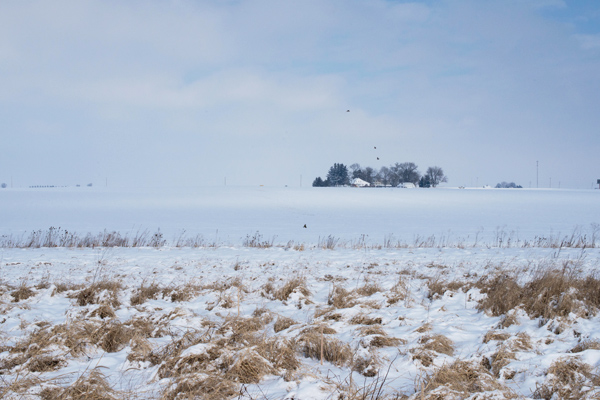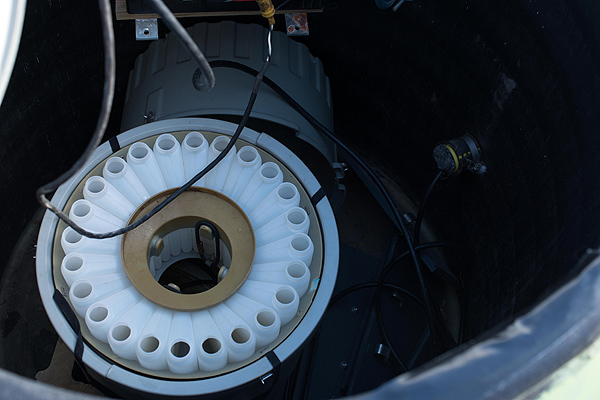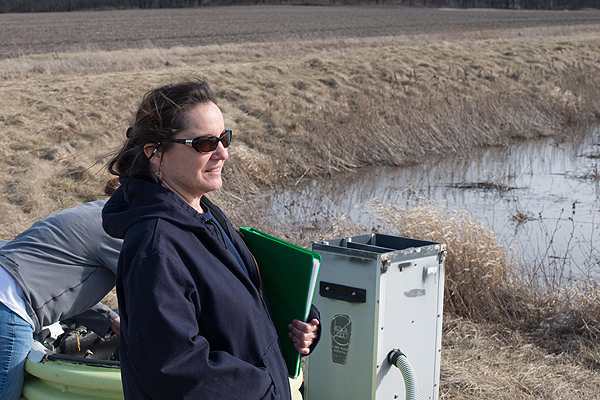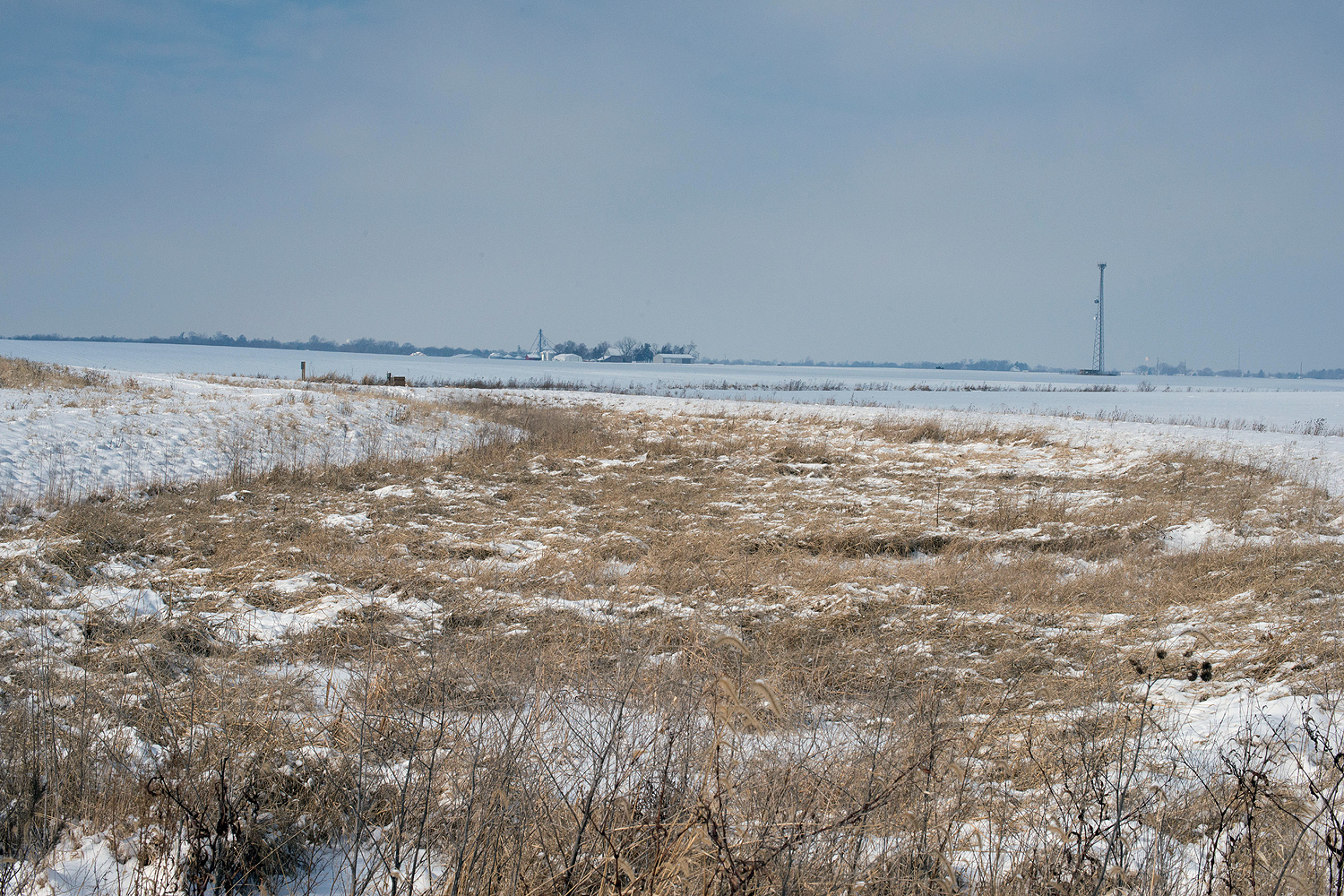Winter isn’t the best time of year to visit a wetland. No fewer than three people offered me this advice, yet it’s 2 degrees Fahrenheit and I’m lost in snow-blanketed central Illinois. Two phone calls and a couple U-turns later, and I reach my destination: a small wetland on the edge of a 30-acre farm outside Princeton, Illinois.
A year and a half ago this 50-foot-wide plot of matted grasses, no deeper than three feet, was productive cropland. Now it’s hard at work removing nitrates, byproducts of the ammonia-based fertilizers put on the farm fields, from the snowmelt runoff that flows through it. The Wetlands Initiative constructed it through a federally funded land conservation program. Jill Kostel, an environmental engineer with the organization, worked with a retired, government-employed soil scientist to convince the landowner to pay $12,000 of his own money to convert this land to into a wetland.
Along with other nonprofits like The Nature Conservancy, the Wetlands Initiative is using a suite of government cost-share programs to convince farmers across Illinois to convert productive farmland to wetlands. Think of them as the earth’s kidneys—they can filter nutrients before they travel to major bodies of water. On average, this wetland removes 64 percent of the nitrates from the water that flows through it, and it’s only a year and a half old. “It will get better as the wetland matures because the system just matures as a whole,” Kostel says.
In the Midwest, where nitrates from farmland runoff are the number one contributor to the Gulf of Mexico dead zone—an area roughly the size of New Jersey where no marine life can survive—a 64 percent removal rate makes a real impact. And according to Kostel, they’re relatively easy to install. The Princeton wetland took about week, but the benefit will be lengthy. “A wetland will just keep working as long as it has water,” she says. Wetlands aren’t the only combatants against rising nitrate levels, but they might be the simplest and most enduring. “It's not like it's done after five years or 15 years. It’s a long-term practice,” she continues.
Apart from its functional existence, farmers and environmentalists alike find these wetlands to be places of value. Kostel tells me that even though the wetland requires little maintenance from the farmers, they often come out to wander through. “One of our landowners is a bird watcher, another’s into pollinators. The other landowner, his dad hunts, and so he's got a little duck blind out there,” she says.
As we walk the length of the wetland, birds hop between the stalks of the tall barnyard grasses, which retain a seed head through the winter months, and hundreds of birds nestle in the wetlands feeding. Void of trees and plants, farmland can look eerily still even in howling wind – the wetland brings a little life to an otherwise dormant landscape. It’s also a reminder of what this land used to look like. As we walk I ask her if this land was originally wetland. “Way back in history,” she answers.
Wetlands are like living organisms, breathing water in and out as they run dry or flood depending on the time of year. With abundant plant and insect life, migratory birds, and small mammals, wetlands are some of the most biologically diverse landscapes on the planet. They’re ecosystems that are constantly in flux, swelling and withering to serve the surrounding landscape as flood-control and waterway buffers, helping to prevent sediment erosion.
Wetlands’ filtration capacity is due to the denitrifiers, the microbial community that lives in the top layers of soil in anaerobic—oxygenless—conditions. The shallow nature of wetlands spurs abundant plant growth because light can penetrate through the water to the soil. As plants grow they pull in carbon from the atmosphere, storing it in their roots. When they die, they decay below the water’s surface, creating an atmosphere void of oxygen and rich with carbon, the ideal condition for microbes to thrive.
When nitrates flow through a wetland with this healthy community of metabolizing microbes, the nutrient gets neutralized. Why? Nitrates are compounds of one nitrogen atom with three oxygen atoms attached. The microbes will eat the oxygen off the nitrate molecules, converting the remaining nitrogen atom to a gas which gets released into our already nitrogen-rich atmosphere, permanently removing nitrates from the ecosystem.
Yet farmers have long viewed wetlands as waste, acres of fertile soil waiting to be drained and farmed. Since the first European settlers, over half of the wetlands in the continental U.S. have been lost, translating to roughly 60 acres of wetlands lost every hour between the 1780s and 1980s. In Illinois alone, over 85 percent of the original wetland acreage was converted to agricultural and urban use in the same span of 200 years. Today, it’s closer to 90 percent. But even when wetlands are drained and the land is plowed, the earth makes a concerted effort to return to its original form, requiring constant monitoring and manipulation to remove the soil’s natural tendency to flood—particularly the clay-based hydric soil in the Midwest, which holds water well.
To avoid drowning crops, farmers tiled their land, meaning they laid a system of underground pipes below cropland to absorb subsurface water from fields and drain it directly into nearby ditches and waterways. In recent decades, perforated plastic replaced ceramic or terracotta as a more cost-effective material to produce tiling.
“There are millions and millions and millions of miles of this subsurface tiling all across the northern-half of Illinois, Iowa, Indiana, Ohio,” says Jeff Walk, director of conservation at The Nature Conservancy. While farmland may appear to be unadulterated flat land, in reality its subsurface hydrology is as complex as a city’s sewer system. In Illinois it is estimated that over over 10 million acres contain tile, 35 percent of the state’s farmland.
That tiling helps route nitrates into streams. Those nitrates often begin as ammonia, the easiest form of nitrogen for crops to absorb, and the basis for most fertilizers. Often ammonia-based fertilizers are applied in the fall, after farmers harvest their crops, and it sits in the soil, susceptible to warm weather and rain. Under these conditions ammonia easily converts to water-soluble nitrates. “And then there it goes,” says Krista Kirkham, an assistant aquatic ecologist at The Nature Conservancy.

An overabundance of nitrates in water do the same thing they were meant to do on land – spur plant growth. But plant growth in water means algae growth, which blocks sunlight and depletes oxygen levels through its decay process. Given a constant source of nutrients, algae can grow as a boundaryless mass in the water, unfurling to create harmful algae blooms and hypoxic dead zones, areas where no marine life can survive.
Nitrates from tile-drained farmland in Illinois are the main contributor to the Gulf of Mexico dead zone, a hypoxic area that costs the Gulf’s fishing industry about $82 million per year, according to the National Oceanic and Atmospheric Administration. Southern Illinois sits roughly 500 miles to the Gulf’s north, but according to the United States Geological Survey, in 2014 the state outranked 30 other states in the Mississippi and Atchafalaya River Basins for its contribution.
In 2011 the Illinois EPA created the Illinois Nutrient Loss Reduction Strategy, a comprehensive suite of best management practices for reducing nutrient loads from urban centers to agricultural runoff. The goal is to reduce its phosphorus load – another common chemical in fertilizer – by 25 percent and its nitrate load by 15 percent by 2025, with an eventual target of a 45 percent reduction of these nutrients to the Mississippi River.
Farmers, too, fear nutrient loss, as it essentially amounts to throwing the money they spend on fertilizers downstream. According to the USDA, in 1997 most farmers in Illinois were losing on average more than 6.5 pounds of nitrogen fertilizer per acre from their fields. They live on a tight margin, cultivating their lands with a strict regimen of inputs to ensure the most profitable crop output.
So why not curb the nutrient flow at the source? Researchers at The Nature Conservancy are working on solutions like pushing farmers to grow cover crops, noncash plantings that can help keep ammonia in the soil, or even to change their fertilizer cycles from fall application to spring. But these solutions are slow to implement. In the meantime, edge-of-field constructed wetlands appear to be a beautiful solution to the nutrient issue. “It's highly effective, and once these wetlands are in they're on pace to work for decades,” says Walk of The Nature Conservancy.
The winter doldrums broke in the Midwest a few weeks after my initial wetlands excursion. It’s sunny, in the mid 60s and I’m in Krista Kirkham’s truck, bouncing across the fields of the privately owned Franklin Research and Demonstration Farm, a research hub and collaboration between the Franklin family and the Nature Conservancy, which is focused on field-based solutions to nutrient reduction from tile-drained agricultural systems.
In 2005 The Nature Conservancy built their first wetland on Franklin Farm using money from a federally funded grant. Today there are three wetlands on the property, each, a highly engineered and monitored testbed with 10 years of data on the effectiveness of wetlands to remove nutrients from the subsurface water. From 2007 to 2016 each wetland removed between 44 and 47 percent of the nitrates from the drainage that ran through them – the future goal of the Illinois Nutrient Loss Reduction Strategy.
The Nature Conservancy decided to implant wetlands at Franklin Farm because of research done by David Kovacic, an ecologist and professor emeritus at the University of Illinois. Beginning work in the early 1990s on the effectiveness of wetlands in removing nitrates from farm runoff, “we got a lot of discouragement,” Kovacic says. “Plenty of people said, oh, these wetland will never work.” But, like the wetlands at Franklin Farm, Kovacic and his team found that the systems they constructed removed 45 percent of the nitrates that entered them.

That’s greater than the amount of nitrates that scientists believe needs to be removed from the Gulf of Mexico in order to stop hypoxia from increasing. A 2001 plan aimed at reducing the Gulf’s hypoxic zone claims that by reducing nitrogen-loads in waters entering the Gulf by just 40 percent, the Gulf would return to a state comparable to its mid-century version. “Our results just completely meshed right with that information,” Kovacic says. “You can do this if you build wetlands.”
Kirkham opens one of the large lime-green cylinders that dot the landscape of Franklin Farm. The Nature Conservancy measures the nutrient levels of the inputs and outputs for each cell of each wetland, and this houses the monitoring equipment. “In every one of these we have one of these ISCO water quality units,” Kirkham says, as we look down at what appears to be a motor and 24 equally sized bottles in a circle. “It's pretty intensive monitoring, trying to capture what's coming in and what's leaving every single wetland,” Kirkham says.
To be effective at removing nitrogen, wetlands don’t need to be very big, just 3 percent the size of the tile-drainage area. The Nature Conservancy tested this theory at Franklin Farm, looking for a size that would be manageable for farmers. “Something that's too small is not going to be effective, something that's too big is taking land out of production unnecessarily, and so what's the happy medium?” Lemke says.
Upfront cost is the prohibitive factor of edge-of-field wetland construction right now. The Princeton wetland cost roughly $60,000 to construct, a huge expense for something that will turn no profit and is not required by law. For this wetland, the landowner received $12,000 through the federal Conservation Reserve Program, but he still had to pay $12,000 of his own money. The Wetlands Initiative paid the remaining $36,000 to complete the project. The Franklin Farm wetlands weren’t as expensive, but again the nonprofit had to cover the gap in costs, as well as pay for upkeep and monitoring.
The cost-share Conservation Reserve Program exists through the Farm Service Agency, an arm of the USDA. In exchange for a yearly rental payment, farmers enrolled in the program agree to remove land from agricultural production for 10-15 years and plant species that will improve environmental health and quality. Under the specific program of CP39, farmers can get up to 90 percent of the eligible costs of constructing a wetland on their crop land covered.
Right now constructing wetlands is difficult and expensive because the practice is so foreign. The Nature Conservancy started the practice a decade ago, constructing 23 wetlands in that time, but their first one was the first edge-of-field wetland constructed in Illinois.
It also makes convincing farmers a real hurdle. “If you’re a farmer, you want to farm,” says Mike Franklin, one of the owners of Franklin Farm. “There’s not a great benefit to these edge-of-field practices, you’re benefiting downstream, so it’s a little harder to get that mentality out there,” Kirkham says.
The farmers who are on board are doing so for a variety of reasons. Jean McGuire, the field outreach coordinator for The Wetlands Initiative, says there’s a small percentage of farmers who think regulation on farmland runoff might be coming, partly because it’s possible to measure the nutrients in runoff now, whereas 100 years ago, it wasn’t. “So, there's the group that says, I just want to be ahead of the curve. The fear of regulation is what is driving some folks.” (When I asked Amy Walkenbach, the watershed management section manager at the Illinois EPA, if the state was moving towards regulating cropland runoff, she responded with a firm “no.”)
For others, the wetlands offer a shorter-term solution. Because wetlands need little monitoring once they’ve matured, some landowners view it as a way to be a conservationist without rearranging all of their production practices. The beauty of a wetland is its simplicity. While the first year can be a little rough, encouraging native plant growth and mowing back weeds, the habitat will usually be pretty self-sufficient by year three or four.

And then there’s the hope that the wetland can take unproductive land out of rotation. According to Kostel and McGuire, most farmers have a part of their land where “you're putting a lot of effort into it and a lot of money and you’re just not making a profit,” Kostel says. Ideally, farmers can enroll this land in the Conservation Reserve Program and by constructing a wetland, earn regular payments on the land that equal or possibly exceed their farming profits.
What landowners are finding, though, is that they really love the wetlands they construct on their property. “The thought of it's kind of scary at first, but once it's out there, they enjoy it,” says Maria Lemke, an aquatic biologist for The Nature Conservancy. Some landowners have even installed trail cams to track the creatures that come into the habitat. “They'll go out and see what's hanging out at the wetland and what's going on there,” she says.
Between the monitoring equipment and the regularity of the wetlands’ size, it’s obvious at Franklin Farm that the wetlands are constructs for research purposes. It’s easy to forget that this highly monitored land conservation practice is home to hundreds of plant and animal species. And just like that, we hear chorus frogs. “Sounds like a finger on a comb,” Lemke says. This land is meant to be wetland – after a bit of coaxing, the soil remembers what it once was and willingly fills with water, allowing cattails and arrowhead to grow, and frogs, muskrats and birds to it make their home.



